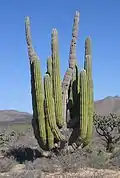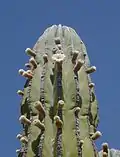| Pachycereus pringlei | |
|---|---|
.jpg.webp) | |
| Pachycereus pringlei in Viscaino, Baja California Sur, Mexico | |
| Scientific classification | |
| Kingdom: | Plantae |
| Clade: | Tracheophytes |
| Clade: | Angiosperms |
| Clade: | Eudicots |
| Order: | Caryophyllales |
| Family: | Cactaceae |
| Subfamily: | Cactoideae |
| Genus: | Pachycereus |
| Species: | P. pringlei |
| Binomial name | |
| Pachycereus pringlei | |
| Synonyms | |
|
Cereus pringlei S.Watson[2] | |
Pachycereus pringlei (also known as Mexican giant cardon or elephant cactus) is a species of large cactus native to northwestern Mexico, in the states of Baja California, Baja California Sur, and Sonora. It is commonly known as cardón, a name derived from the Spanish word cardo, meaning "thistle"; additionally, it is often referred to as sabueso (or “bloodhound”), which is possibly an early Spanish interpretation of the native Seri term for the plant, xaasj.[3]
Large stands of this cactus still exist, but many have been destroyed as land has been cleared for cultivation in Sonora.
The cactus fruits were always an important food for the Seri people, in Sonora; the dried cactus columns themselves could be used for construction purposes, as well as for firewood.[4]
A symbiotic relationship with bacterial and fungal colonies, on its roots, allows P. pringlei to grow on bare rock, even where no soil is available at all; the cactus has the distinction of being lithophytic as needed. The root’s bacterial colonies can fix nitrogen from the air and break down the rock to expose hidden sources of nutrients. The cactus even evolved to maintain this symbiotic bacteria within its seeds, serving to benefit by taking it on as part of its very physical biology.[5][6][7]
Morphology
A cardon specimen is the tallest living cactus in the world, with a maximum recorded height of 19.2 m (63 ft 0 in),[8][9] with a stout trunk up to 1 m (3 ft 3 in) in diameter bearing several erect branches. In overall appearance, it resembles the related saguaro (Carnegiea gigantea), but differs in being more heavily branched and having branching nearer the base of the stem, fewer ribs on the stems, blossoms located lower along the stem, differences in areoles and spination, and spinier fruit.
Its flowers are white, large, nocturnal, and appear along the ribs as opposed to only apices of the stems.
Lifespan and growth
An average mature cardon may reach a height of 10 metres (30 ft), but individuals as tall as 18 metres (60 ft) are known.[10] It is a slow-growing plant [11] with a lifespan measured in hundreds of years. One way scientists have aged these cacti has been to use radiocarbon dating to test the spines closest to the ground.[12] Growth can be significantly enhanced in its initial stages by inoculation with plant growth-promoting bacteria such as Azospirillum species.[13][14][15] Most adult cardon have several side branches that may be as massive as the trunk. The resulting tree may attain a weight of 25 tons.[16]
Gallery
 Habit
Habit With an osprey nest atop
With an osprey nest atop Flowering
Flowering.jpg.webp) Husk of a fallen fruit
Husk of a fallen fruit With human for scale
With human for scale Spines
Spines Close up of a single plant
Close up of a single plant
Notes
References
- ↑ Burquez Montijo, A. (2017) [amended version of 2013 assessment]. "Pachycereus pringlei". IUCN Red List of Threatened Species. 2017: e.T151996A121574684. doi:10.2305/IUCN.UK.2017-3.RLTS.T151996A121574684.en. Retrieved 10 March 2022.
- ↑ "Pachycereus pringlei". Germplasm Resources Information Network. Agricultural Research Service, United States Department of Agriculture. Retrieved 2011-11-03.
- ↑ Chamlee, Bob. "Cardón cactus, Pachycereus pringlei". Los Cabos Guide to Good Eating and More!. Archived from the original on 2006-04-15. Retrieved 2011-11-03.
- ↑
- Felger, Richard; Mary B. Moser. (1985). People of the desert and sea: ethnobotany of the Seri Indians. Tucson: University of Arizona Press. ISBN 0-8165-0818-6.
- ↑ Puente, M. E.; Y. Bashan; C. Y. Li; V. K. Lebsky (September 2004). "Microbial populations and activities in the rhizoplane of rock-weathering desert plants. I. Root colonization and weathering of igneous rocks". Plant Biology. Stuttgart. 6 (5): 629–42. doi:10.1055/s-2004-821100. PMID 15375735.
- ↑ Puente, M. E.; C. Y. Li; Y. Bashan (September 2004). "Microbial populations and activities in the rhizoplane of rock-weathering desert plants. II. Growth promotion of cactus seedlings". Plant Biology. Stuttgart. 6 (5): 643–50. doi:10.1055/s-2004-821101. PMID 15375736.
- ↑ Walker, Matt (2009-08-19). "How cacti become 'rock busters'". BBC News.
- ↑ Salak, M. "In search of the tallest cactus". Cactus and Succulent Journal. 72 (3).
- 1 2 "Windstorm Fells 78-Foot Cactus--Tallest in World". Retrieved 2015-08-04.
- ↑ (León de la Luz and Valiente 1994).
- ↑ (Roberts, 1989)
- ↑ Delgado-Fernández, Mariana; Garcillán, Pedro P; Ezcurra, Exequiel (September 2016). "On the Age and Growth Rate of Giant Cacti: Radiocarbon Dating of the Spines of Cardon ( Pachycereus Pringlei )". Radiocarbon. 58 (3): 479–490. doi:10.1017/RDC.2016.25. ISSN 0033-8222. S2CID 130664993 – via Cambridge Journals.
- ↑ (Bashan et al., 1999
- ↑ Carrillo et al., 2000
- ↑ Puente and Bashan, 1993
- ↑ (Gibson and Nobel, 1986).
External links
 Media related to Pachycereus pringlei at Wikimedia Commons
Media related to Pachycereus pringlei at Wikimedia Commons Data related to Pachycereus pringlei at Wikispecies
Data related to Pachycereus pringlei at Wikispecies- Cacti Guide: Pachycereus pringlei
- Video of a Cardón Planting
- cactus puns
